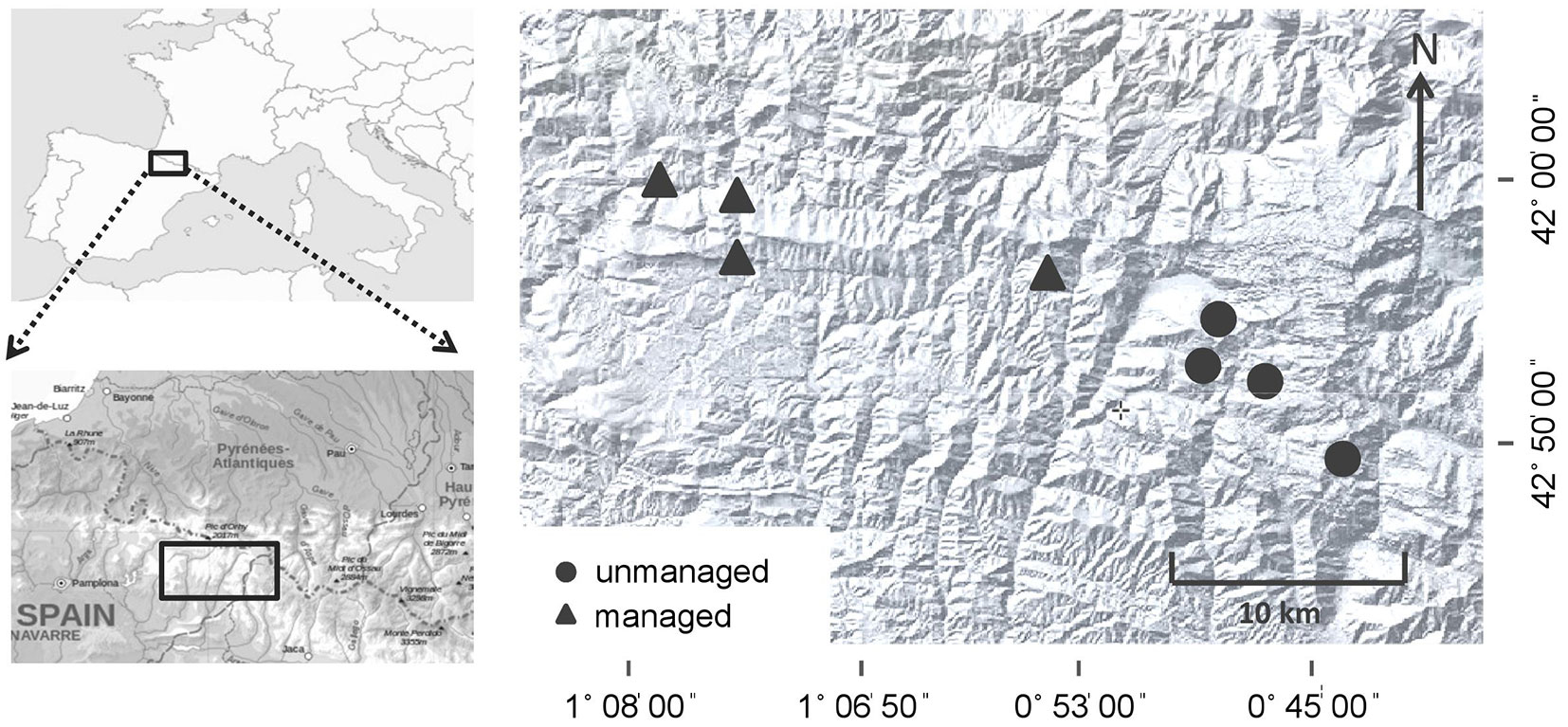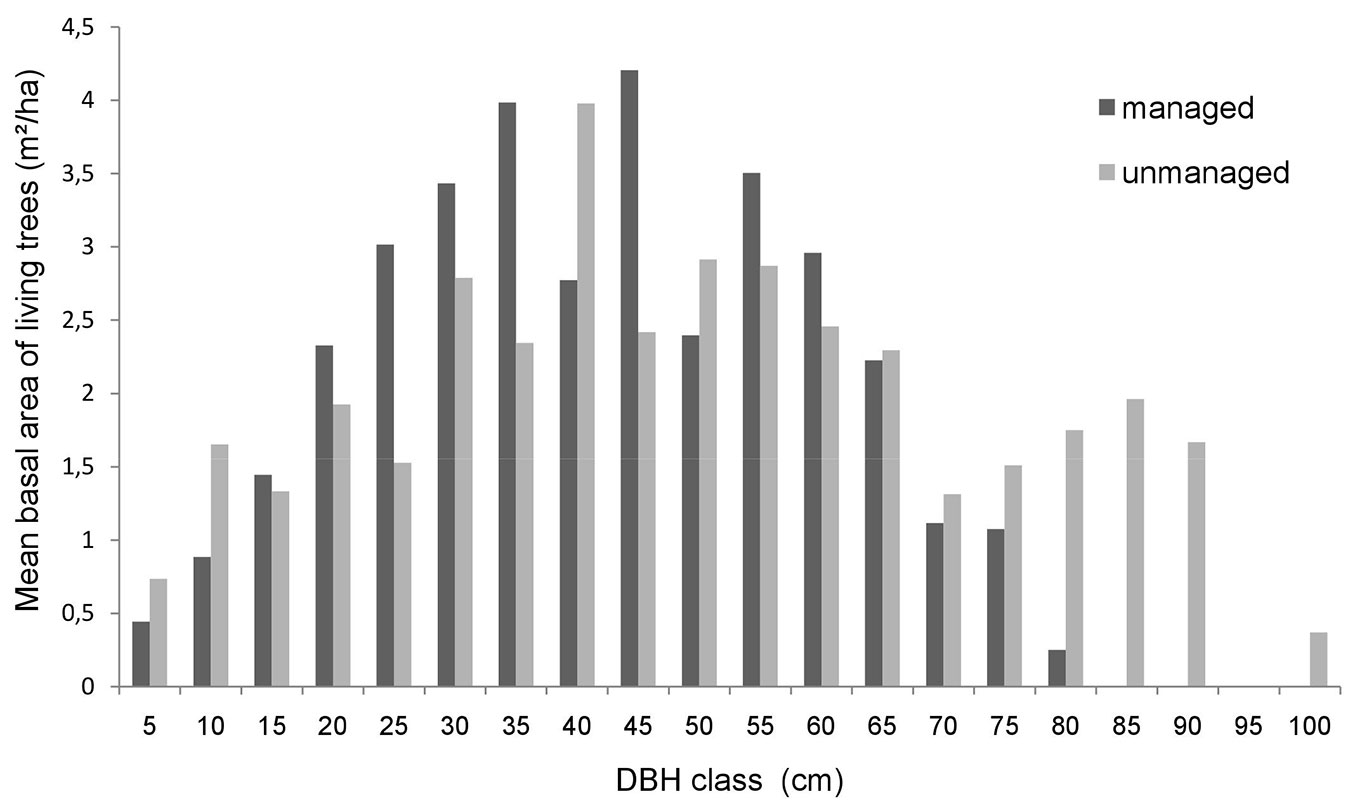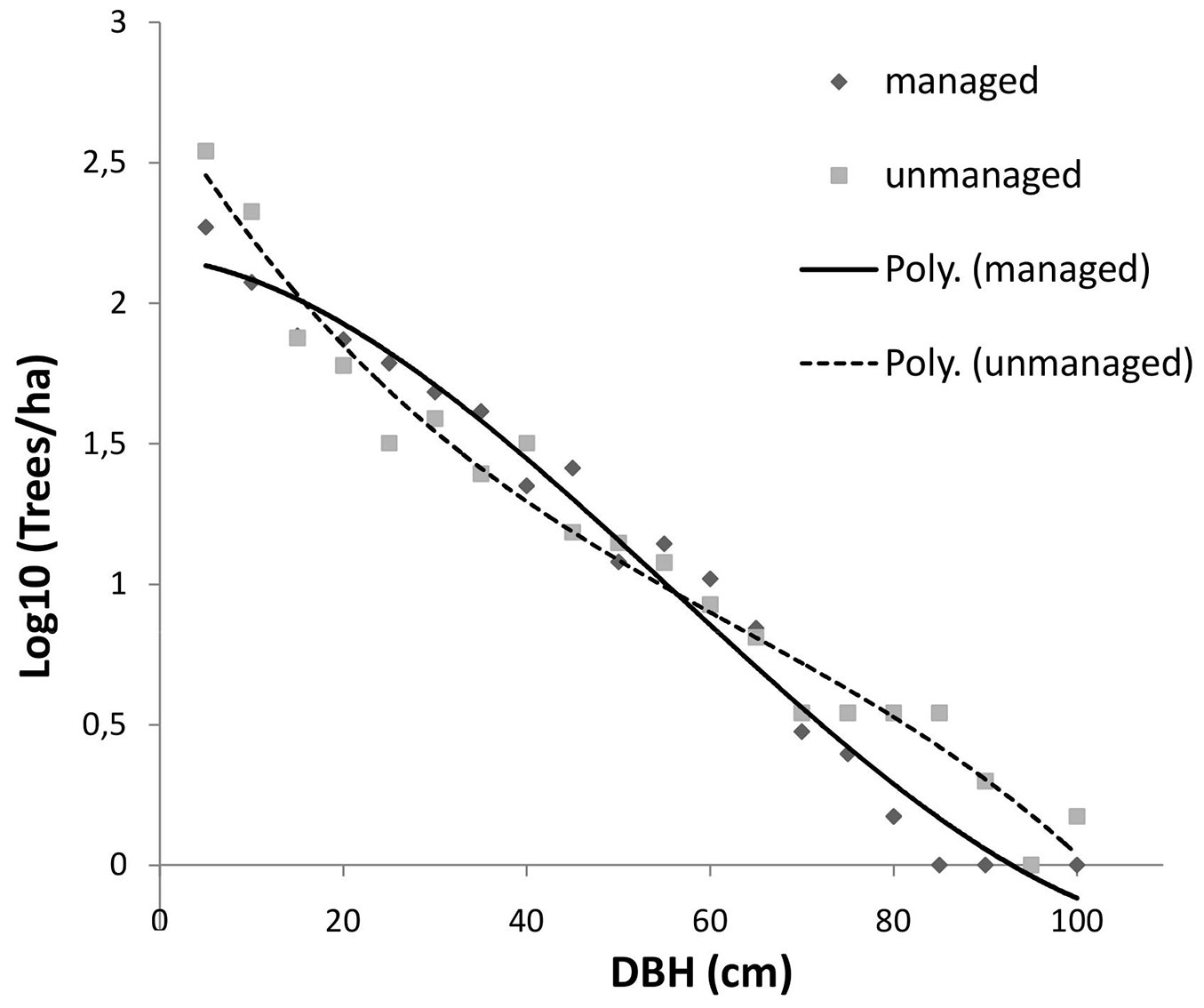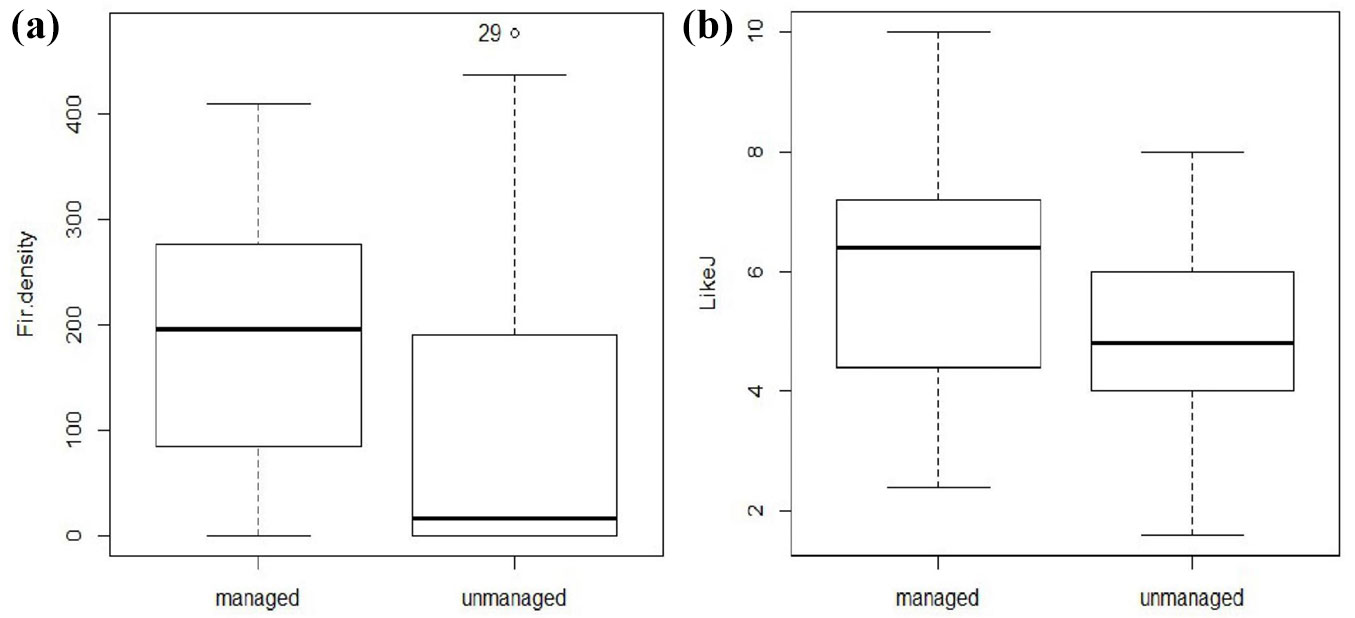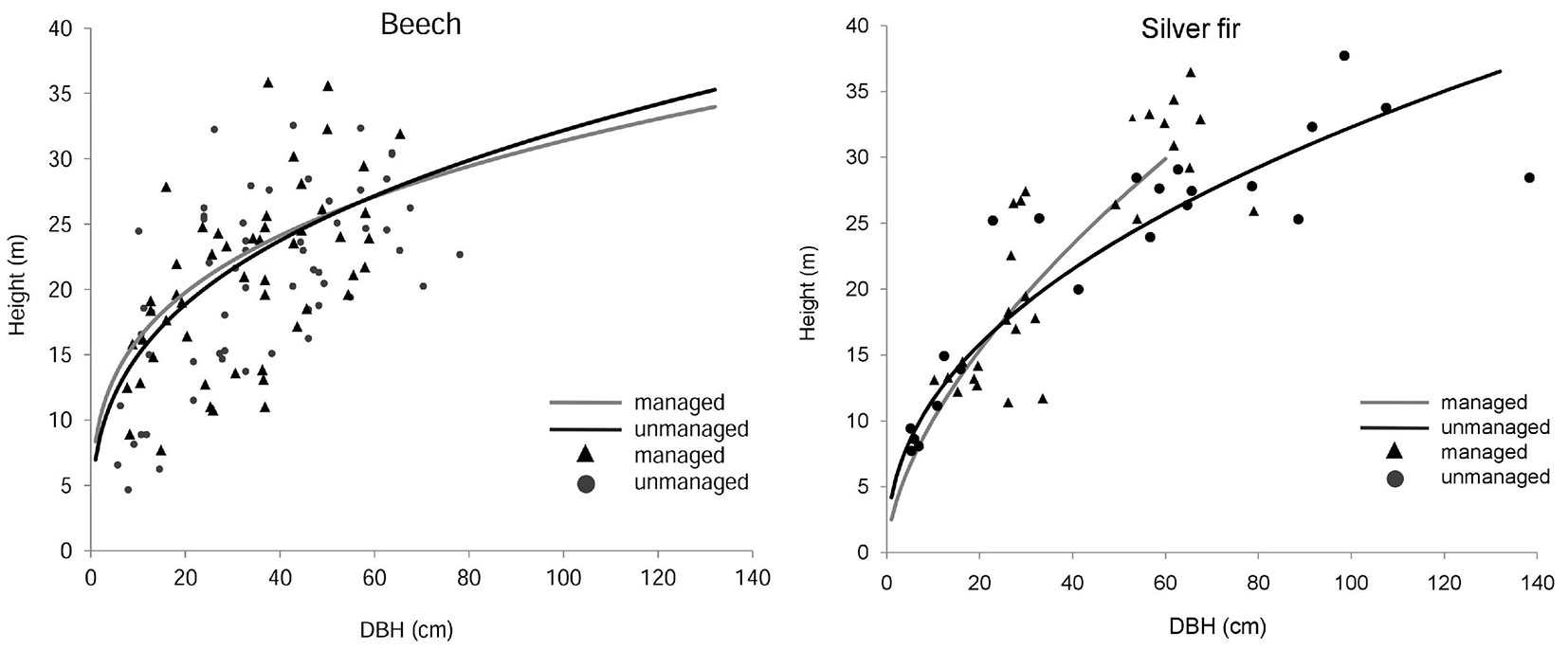
Managed and unmanaged silver fir-beech forests show similar structural features in the western Pyrenees
iForest - Biogeosciences and Forestry, Volume 11, Issue 5, Pages 698-704 (2018)
doi: https://doi.org/10.3832/ifor2720-011
Published: Oct 23, 2018 - Copyright © 2018 SISEF
Research Articles
Abstract
Forest structure is considered one of the basic features of the forest ecosystem and it is widely studied with the aim of developing sustainable management strategies. The usual approach is to compare structural features of stands in managed and unmanaged forests. Managed stands are those disturbed in some way by silvicultural practices, whereas unmanaged stands are subject to natural disturbance dynamics and may serve as a reference. Up to now, there has been insufficient research into sustainable management strategies for Pyrenean silver fir-beech forests and the structure of managed and unmanaged stands has not yet been evaluated. The aim of this study is to provide a detailed characterisation of the structural attributes of these mixed mountain forests in the western Pyrenees and compare managed and unmanaged stands regarding selected stand parameters. Potential differences between managed and unmanaged stands were assessed with Mann-Whitney U-tests. Diameter distribution was modelled using third-order polynomials and non-linear regression was performed to compare the tree heights in managed and unmanaged stands. Stand structure was similar in both management categories. The diameter distribution of Pyrenean unmanaged silver fir-beech stands showed a tendency towards a rotated sigmoid distribution. Our results indicate that the recommended diameter distribution has been preserved in managed stands despite they were intensively managed in the past, whilst the unmanaged stands are still in the process of developing old-growth attributes because management was abandoned too recently for significant changes in forest structure to have occurred.
Keywords
Introduction
Stand structure is a functional feature of the forest ecosystem ([30]) reflecting the relationships among individual trees and the environment, and is the outcome of processes including competition and biomass control ([40]). The term forest structure generally refers to the horizontal and vertical spatial distribution of plant species ([43]). Forest stand structure is determined by tree species composition, stand dynamics, stand conditions and natural disturbances, and is also directly affected by forest management. Silvicultural practices change horizontal and vertical stand structure considerably, creating gaps in the forest canopy and changing the light regime. Creation of gaps initiates regeneration processes in the understory, thus affecting stand dynamics ([42]). The understory microclimate is also dependent on canopy structure, particularly canopy density ([1]). Moreover, forest structure may influence edaphic factors such as soil water content, pH, temperature and nutrient availability ([3]). Because forest structure strongly influences environmental conditions in the understory it has been considered a key determinant of biodiversity patterns in forest ecosystems ([12]). To assess how management affects stand structure one must estimate stand parameters such as the distribution of diameters, tree density, tree height, canopy closure and the quantity of dead wood. In view of the importance of forest structure, modern forestry strives to balance economic and ecological needs through appropriate management methods.
The concept of sustainable forest management is based on the emulation of natural processes, which can be studied in unmanaged forests. Unmanaged forests provide valuable information for developing management strategies and effective conservation policies because their dynamics has not been affected by human intervention ([8]), whereas in managed forests the natural processes have been disturbed in some way, with the intensity of the disturbance depending on the management strategy applied.
Forest structure has been evaluated in many managed and unmanaged European forests ([7], [5], [6], [39], [36]), but there is a dearth of information about Pyrenean forests ([13]). Forests dominated by silver fir (Abies alba Mill.) and European beech (Fagus sylvatica L.) in the Pyrenees have been managed over the centuries, but their management history is not completely clear as documentation of silvicultural practices is scant. The available management history for the region ([24]) suggests that most of the western Pyrenean forests were over-exploited at the beginning of the 20th century, either through timber exploitation or grazing. There were frequent changes in the approach to managing these mixed stands, with selection systems, shelterwood, clearcuts or exclusive silver fir logging all being applied at some point. In the last 50 years human migration and the abandonment of these activities have led to increases in forest cover and growing stock ([24]). At present, most of the forests in the western Pyrenees are subjected to regular management, which promotes sustainable forest management ([24]), the exceptions are areas within natural parks or strict reserves, which remain unmanaged.
In the context of forest management in the Pyrenees, the present study aims to provide for the first time a detailed characterisation of the structural attributes of these mixed mountain forests and to compare managed and unmanaged stands regarding selected stand parameters. We hypothesised that stand structure would differ between actively managed stands and well-preserved remnants never subjected to intensive forest management and withdrawn from the management plans 40 years ago.
Material and methods
Study area
The study area is located in the western part of the Pyrenees, specifically in the Spanish part of the massif, which encompasses the regions of Navarre and Aragon (Fig. 1). The landscape is characterised by valleys and mountains stretching from west to east and ranging in elevation from 1800 to 2500 m a.s.l. The bedrock is limestone and marly flysch, with brown soils. Biogeographically the area belongs to the Alpine region and according to the Global Bioclimatic Classification System developed by Rivas-Martínez ([31]), the bioclimate is temperate oceanic, with a mean annual temperature of 8° C, mean annual rainfall of 1419 mm and a W-E continentality gradient. A long history of livestock and forest exploitation has shaped the landscape in this area, which is highly heterogeneous and, in the beech belt, contains semi-natural grasslands, scrublands, natural forests and Pinus sylvestris L. plantations. Silver fir reaches its southwestern distribution limit in the western Pyrenean beech belt, growing in mixed stands together with beech and even dominating in some stands. The silver fir-beech forests of the study area are included in the association Scillo lilio-hyacinthi-Fagetum sylvaticae Br.-Bl. ex O. Bolòs 1957, which encompasses ombrophilous hyper-humid forests ([32]). The management history of these stands is unclear because silvicultural practices during the last century were unsystematic and varied in intensity. According to the Forest Management Plan of Navarre ([24]) a great variety of management approaches have been recorded (single and group selection systems, shelterwood and exclusive fir exploitation). The westernmost stands were intensively managed in the past and currently they are subjected to regular forest management, whereas the easternmost stands have mostly been abandoned for at least 40 years, have never been intensively managed and lie within natural parks and strict reserves.
Sampling design
We identified all north-facing stands of silver fir-beech forests exceeding 30 ha, between 800 and 1700 m a.s.l. Twenty stands encompassing a total of approximately 700 ha fulfilled these criteria. We defined managed stands as those managed between 5 and 20 years ago and unmanaged stands as those where no regular management occurs and timber has not been harvested for at least 40 years. The rarity of well-preserved forests in the western Pyrenees meant we were only able to sample four unmanaged stands. To provide a balanced sampling we also selected four managed stands with similar site conditions. Four plots were randomly sampled in each stand (see Tab. S1 in Supplementary material). This resulted in a total of 32 plots grouped into eight clusters (Fig. 1). Field sampling was carried out in 2015 under permits from the Government of Navarre and Aragon.
Stand structure sampling (Tab. 1) was based on measuring diameter-at-breast-height (DBH) for all trees within three concentric circles with radii of 4, 13 and 20 m. We recorded all standing trees (living and dead) that exceeded a pre-established DBH threshold in each circle: 2.5 cm for the 4-m radius circle, 10 cm for the 13-m radius circle and 50 cm for the 20-m radius circle. For the dead standing trees, we used the term “snags”. Deadwood was quantified by measuring the diameter of all the lying dead wood components (logs) of diameter ≥ 10 cm within the 13-m radius circle. We classified the decay stage of logs according to Hunter’s ([18]) framework, which distinguishes five decay classes ranging from freshly fallen (decay class 1) to heavily decomposed (decay class 5). The tree heights were measured with the Haglof Vertex hypsometer for five individuals out of those whose DBH was measured, in total 160 trees randomly chosen within the sampled stands. Living wood volume was not calculated due to the lack of volume tables for this area.
Tab. 1 - Topographic, stand structural and light condition variables for 32 plots used in the comparison of managed and unmanaged stands in the western Pyrenean silver fir-beech forests. Differences between managed and unmanaged plots were tested using Mann-Whitney’s U test. (Gaps): percentage of large gaps; (CV_DBH): coefficient of diameter variation; (*): p < 0.05; (**): p < 0.01; (***): p < 0.001.
| Group | Variables | Units | Mean ± SD | p value | |
|---|---|---|---|---|---|
| Managed | Unmanaged | ||||
| Topography | Elevation | m a.s.l. | 1118 ± 104.70 | 1447 ± 140.76 | <0.001*** |
| Slope | % | 46.62 ± 16.21 | 39.19 ± 12.40 | 0.19 | |
| Light conditions | Transmission | % | 10.81 ± 6.13 | 11.20 ± 2.67 | 0.36 |
| Gaps | % | 6.70 ± 5.50 | 5.9 ± 2.28 | 0.89 | |
| Stand structure | Tree density | N ha-1 | 638 ± 286 | 806 ± 617 | 0.83 |
| Beech density | N ha-1 | 517 ± 389 | 783 ± 650 | 0.25 | |
| Fir density | N ha-1 | 188 ± 130 | 111 ± 16 | 0.03* | |
| Density of small trees | N ha-1 | 11.25 ± 8.31 | 13.56 ± 10.22 | 0.52 | |
| Density of medium trees | N ha-1 | 10.43 ± 5.42 | 7.18 ± 4.57 | 0.07 | |
| Density of large trees | N ha-1 | 5.00 ± 2.50 | 4.43 ± 2.03 | 0.30 | |
| Density of very large trees | N ha-1 | 0.75 ± 0.93 | 1.93 ± 1.94 | 0.09 | |
| Density of very large fir trees | N ha-1 | 3.97 ± 5.81 | 12.43 ± 15.90 | 0.20 | |
| Density of very large beech trees | N ha-1 | 1.98 ± 6.16 | 2.98 ± 5.71 | 0.42 | |
| Basal area of living trees | m2 ha-1 | 34.95 ± 9.41 | 35.20 ± 12.61 | 0.79 | |
| Basal area of beech | m2 ha-1 | 21.66 ± 7.89 | 22.93 ± 9.31 | 0.53 | |
| Basal area of fir | m2 ha-1 | 14.37 ± 11.06 | 14.51 ± 17.13 | 0.44 | |
| Basal area of snags | m2 ha-1 | 1.21 ± 2.47 | 2.27 ± 2.70 | 0.08 | |
| Basal area of logs | m2 ha-1 | 3.89 ± 3.91 | 2.21 ± 1.80 | 0.46 | |
| Basal area of total dead wood | m2 ha-1 | 5.09 ± 4.18 | 4.53 ± 2.77 | 0.95 | |
| Number of stumps | N plot-1 | 3.68 ± 2.86 | 2.18 ± 3.63 | 0.05 | |
| CV_DBH | - | 50.40 ± 18.23 | 62.36 ± 17.77 | 0.06 | |
| LikeJ index | - | 6.05 ± 2.05 | 4.95 ± 1.68 | 0.10 | |
We distinguished four diameter categories in living trees: very large trees (DBH ≥ 67.5 cm), large trees (47.5 ≤ DBH < 67.5 cm), medium trees (22.5 ≤ DBH < 47.5 cm) and small trees (7.5 ≤ DBH < 22.5 cm). The structural diversity of each plot was expressed as the coefficient of diameter variation (CV_DBH - Tab. 1).
We evaluated stand structure using the LikeJ index ([14]), which describes how closely the diameter distribution approximates a J-shape. This index is based on the number of stems per hectare in different diameter classes; the maximum value of closeness to the inverse J shape is 10 ([14]). Traditionally the inverse J-shaped distribution has been regarded as the desirable distribution for diameter in managed forests showing heterogeneity in age ([25]), but old-growth forests, which could serve as a model, show a variety of diameter distributions ([41]).
Light condition variables (Tab. 1) were obtained by hemispherical photography. A detailed light sampling and analysis protocol is provided in Appendix 1 (Supplementary material). We calculated the following variables: “transmission”, a measure of overall canopy openness or total gap fraction, and “gaps”, the proportion of large between-crown gaps.
Data analysis
The structural features of managed and unmanaged stands are represented in figures and tables compiled to make data visualisation. Differences between the management categories with respect to selected stand parameters and topographic variables were assessed with Mann-Whitney U-tests (Tab. 1). Diameter distribution was modelled using third-order polynomials where tree density was converted to a logarithmic scale. Non-linear regression was performed to compare the tree heights in managed and unmanaged stands as this permits tree height to be predicted from observed DBH. The regression was fitted using the power equation h = a(DBH)b ([17]), where h is the tree height and a and b are estimated parameters.
Results
The tree layer was dominated by European beech (Fagus sylvatica), followed by silver fir (Abies alba), whilst the tree species Acer opalus Mill., Sorbus aucuparia L., Salix caprea L. and Tilia platyphyllos Scop. were recorded as saplings ([16]). “Transmission” and “gaps” were highly correlated. Average transmission was 11.1%, and the mean percentage of large gaps was 6.3%, so large gaps accounted for more than half of the canopy openness. The percentage of large gaps was similar (p > 0.05) in managed and unmanaged stands (Tab. 1).
The per-hectare basal area of living trees was similar (p > 0.05) in managed and unmanaged stands (Tab. 1), as well as the total basal area of small, medium, large and very large trees (results not shown). However, trees in the diameter classes over 85 cm were absent from managed stands (Fig. 2). Like mean basal area, total tree density and densities of small, medium, large and very large trees were similar in both management categories (p > 0.05 - Tab. 1, Fig. 3), however unmanaged stands tended to have higher density of small and very large trees (Fig. 3). Separate analyses of individual species revealed that beech density was similar in managed and unmanaged stands (p > 0.05), but the density of silver fir was greater in the managed stands (p < 0.05 - Tab. 1, Fig. 4a). In sampled stands the LikeJ index varied from 1.6 to 10 and was similar in managed and unmanaged stands (p > 0.05), although in absolute terms unmanaged stands tended to have lower LikeJ values (Fig. 4b).
Fig. 2 - Distribution of basal area of living trees by DBH classes in managed and unmanaged stands of silver fir-beech forests in the western Pyrenees.
Fig. 3 - Diameter distribution modeled using a third-order polynomial in the managed and unmanaged stands of silver fir-beech forests in the western Pyrenees.
Fig. 4 - (a) Boxplot of fir density per hectare in managed and unmanaged stands of silver fir-beech forests in the western Pyrenees. Fir density was significantly higher in managed stands than in unmanaged ones (p< 0.05). (b) Boxplot of LikeJ index, closeness to an inverse J shape, in the managed and unmanaged silver fir-beech stands from the western Pyrenees. Regarding the LikeJ index, managed and unmanaged stands did not differ significantly (p> 0.05). Maximum value of LikeJ index is 10, describing desirable forest structure for uneven-aged managed forests.
The total basal area of dead wood was similar in managed and unmanaged stands (Tab. 1). Decay class 2 was the most frequent in all stands and decay class 5 was absent from unmanaged stands (Tab. 2).
Tab. 2 - Percentage of dead wood across the decay classes in managed and unmanaged stands in silver fir-beech forests in the western Pyrenees.
| Decay class | % of total dead wood per plot | |
|---|---|---|
| Managed | Unmanaged | |
| 1 | 24.10 | 33.33 |
| 2 | 34.94 | 43.94 |
| 3 | 22.89 | 19.70 |
| 4 | 15.66 | 3.03 |
| 5 | 2.41 | 0 |
There were no differences in the height-diameter curves for beech between both management types (Fig. 5). However, the model showed a low fit (R2= 0.33 and R2= 0.41 for managed and unmanaged stands, respectively) because of the height variability within DBH classes. The silver fir height model had a better fit in both managed and unmanaged stands (R2 = 0.71, R2= 0.83) and slightly different curves were obtained for both categories. Silver fir of DBH = 60 cm reached a greater height in managed stands than in unmanaged stands (Fig. 5).
Fig. 5 - Height-diameter models of beech and silver fir for managed and unmanaged stands in the western Pyrenees. The equation for the beech trees in the managed stands is h = 8.3 × DBH0.287, with R2 = 0.33; for unmanaged stands, h = 6.973 × DBH0.332, with R2 = 0.41. The equation for the fir trees in the managed stands is h = 2.5 × DBH0.666 with R2 = 0.71; for unmanaged stands, h = 4.17 × DBH0.444, with R2 = 0.83.
Discussion
Mean values for canopy openness were low (approximately 10%) in both the managed and unmanaged Pyrenean forests studied, suggesting a rather closed canopy. The gap fraction values in the sampled forests were within the range of values reported for unmanaged stands in Central Europe, where gap fraction varies between 3 and 16% ([20]). The low gap fraction and the small size of the gaps suggest that unmanaged Pyrenean forests follow a pattern of small-scale disturbance, which has also been found in other well-preserved beech forests ([34], [15]). In the case of managed Pyrenean stands the low gap fraction and small gap size (never exceeding 400 m2 - [16]) suggest that management is not intensive and emulates natural forest dynamics. However, point data on gap fraction only provide a static picture of the status of a forest ([19]), so further research on gap dynamics is needed to draw firm conclusions.
Compared with European old-growth forests ([8]), the unmanaged stands of the studied Pyrenean forests showed a lower mean basal area per hectare, which we attribute to the short period of forest abandonment. These unmanaged stands are located at the highest elevations, following a spatial pattern already reported in the Apennines ([29]), where low soil productivity and unfavourable climatic conditions could potentially affect tree growth and basal area ([8]). However, evidence for our conclusion that forest management has a greater negative effect on basal area than elevation comes from the presence of large fir trees at the highest elevations (1600 m a.s.l.) of the Aztaparreta old-growth forest.
Although we did not find differences in basal area between both management categories, we did observe a shift towards larger diameter classes (> 80 cm) in unmanaged stands, which could be a consequence of management cessation.
Tree density was similar in managed and unmanaged stands for the categories of small, medium, large and very large trees. However, the diameter distribution varied slightly with management category. The main difference observed was that unmanaged stands tended to have a higher density of very small trees, as a consequence of natural regeneration and lack of management practices, as well as a higher density of the largest trees due to management cessation. Having a high density of small and large trees, the diameter distribution of unmanaged stands showed tendency to a rotated-sigmoid curve, which is one of the known distribution of old-growth forests ([37], [41]).
The minimum value of the LikeJ index was measured in the old-growth forest Aztaparreta, where natural dynamics prevail and in which biomass is accumulated in the largest DBH classes. Medium LikeJ values in the managed forests may reflect the mixture of management approaches used in these forests. Assuming that forest sustainability can be evaluated by diameter distribution ([33]), Pyrenean forests can be considered relatively stable systems, with unmanaged forests being in the recovery stage after the abandonment of past management practices.
The greater density of silver firs in the managed stands may be a consequence of recent forest management practices that favour silver fir. Since silver fir decline has been confirmed in this area ([26]), forest managers have adapted their management practices in order to preserve this species ([24]). Lower fir density in the unmanaged stands may indicate that silver fir does not regenerate well, perhaps due to the dominance of beech ([11]), although the reasons for the lack of fir regeneration remains an open question ([26]).
The height-diameter model for beech showed great height dispersion across the diameter classes, indicating that the beech trees of similar diameter had very different heights. This observation could be because beech is a shade-tolerant species, with saplings of up to 35 years ([9]). Tree height increases slowly in these multilayered stands, where light levels are low, but when the canopy opens saplings take advantage and their height increases rapidly ([23], [34]). Similar findings have been reported for beech forests where trees in the upper storey were 22 m high and varied widely in diameter, from 20 to 100 cm ([10], [34]).
With respect to the fir height-diameter model, firs in the 60 cm DBH class were taller in the managed stands than in the unmanaged ones, probably as a result of current forest management, which removes competition for light, water and nutrients from beech trees, thus favouring fir growth. This interpretation is consistent with the higher fir density found in the managed stands. Tree heights may also depend on site quality; in particular silver fir stand productivity depends on rainfall and temperature, rather than soil properties ([4], [28]). Soil properties in the sampled stands were similar with respect to clay percentage, organic matter and nitrogen (Horvat et al., unpublished results), so we have excluded the possibility that these factors affected tree height. The managed and unmanaged stands in our study have similar annual precipitation, although they are spatially clustered, and so water availability should not be a limiting factor. Another feature observed in managed forests was the absence of large fir trees, also a consequence of past forest management, which was oriented towards the logging of large silver firs ([35]).
Surprisingly, the total basal area of dead wood did not vary between managed and unmanaged stands, in contrast with the findings of other studies ([21], [38]). This indicates that forest managers are applying appropriate management strategies, mainly involving retention of a certain quantity of logs and snags to enhance biodiversity. Although fewer stumps were counted in unmanaged stands, differences regarding the number of stumps were not significant between both management categories. This fact confirms that the abandonment of management is relatively recent, given that total decomposition of coarse woody debris from beech takes about 35 years ([22]). Nevertheless, more detailed studies on dead wood quantity are needed, as in this study we have used the basal area of dead wood as an approximate index of dead wood quantity.
From the obtained results, we infer that these unmanaged stands are still on the way to become old-growth stands. Management ceased approximately 40 years ago, so these forests have not yet developed clear old-growth attributes, because the recovery of ecosystems after cessation of management is a rather slow process ([2], [27]).
Conclusions
Our study has analysed the differences in stand structure of managed and unmanaged silver fir-beech forests in the western Pyrenees. The unmanaged forests tend to have fewer stumps, a higher density of small trees and an increased basal area in larger DBH classes, although the managed and unmanaged forests have a similar structure. These unmanaged stands are still on the way to become old-growth stands whilst managed forests, which showed a high variation in tree diameter, are under sustainable management practices. Silvicultural practices should focus on the preservation of the natural proportions of fir and beech, although the observed decline in silver fir provides a rationale for management strategies that favour this species.
List of abbreviations
DBH: diameter-at-breast-height; CV_DBH: coefficient of diameter variation.
Acknowledgements
VH and JGV performed the field measurements. VH performed the statistical analysis and led the writing, and IB and IGM contributed to the study design and revision of manuscript. We thank Almudena Pereda and Raul Ilundain for help with field work and Francesco Sabatini and Sabina Burrascano for assistance with the sampling protocol. Funds from the project IT299-10 for research groups of the Basque Government were used for this study.
References
CrossRef | Gscholar
Gscholar
Gscholar
Gscholar
Gscholar
Gscholar
Authors’ Info
Authors’ Affiliation
Jorge García De Vicuña
Idoia Biurrun
Itziar García-Mijangos
Dept. Plant Biology and Ecology, University of the Basque Country UPV/EHU, P. O. Box 644, Bilbao (Spain)
Corresponding author
Paper Info
Citation
Horvat V, García De Vicuña J, Biurrun I, García-Mijangos I (2018). Managed and unmanaged silver fir-beech forests show similar structural features in the western Pyrenees. iForest 11: 698-704. - doi: 10.3832/ifor2720-011
Academic Editor
Gianluca Piovesan
Paper history
Received: Jan 03, 2018
Accepted: Jul 26, 2018
First online: Oct 23, 2018
Publication Date: Oct 31, 2018
Publication Time: 2.97 months
Copyright Information
© SISEF - The Italian Society of Silviculture and Forest Ecology 2018
Open Access
This article is distributed under the terms of the Creative Commons Attribution-Non Commercial 4.0 International (https://creativecommons.org/licenses/by-nc/4.0/), which permits unrestricted use, distribution, and reproduction in any medium, provided you give appropriate credit to the original author(s) and the source, provide a link to the Creative Commons license, and indicate if changes were made.
Web Metrics
Breakdown by View Type
Article Usage
Total Article Views: 44334
(from publication date up to now)
Breakdown by View Type
HTML Page Views: 38252
Abstract Page Views: 2394
PDF Downloads: 2819
Citation/Reference Downloads: 8
XML Downloads: 861
Web Metrics
Days since publication: 2609
Overall contacts: 44334
Avg. contacts per week: 118.95
Article Citations
Article citations are based on data periodically collected from the Clarivate Web of Science web site
(last update: Mar 2025)
Total number of cites (since 2018): 10
Average cites per year: 1.25
Publication Metrics
by Dimensions ©
Articles citing this article
List of the papers citing this article based on CrossRef Cited-by.
Related Contents
iForest Similar Articles
Review Papers
Structure and management of beech (Fagus sylvatica L.) forests in Italy
vol. 2, pp. 105-113 (online: 10 June 2009)
Research Articles
Regeneration of Abies pinsapo within gaps created by Heterobasidion annosum-induced tree mortality in southern Spain
vol. 7, pp. 209-215 (online: 27 February 2014)
Research Articles
Long-term dynamics of stand structure and regeneration in high-stocked selection fir-beech forest stand: Croatian Dinarides case study
vol. 14, pp. 383-392 (online: 24 August 2021)
Research Articles
Effects of gap size and within-gap position on seedlings establishment in silver fir stands
vol. 1, pp. 55-59 (online: 28 February 2008)
Review Papers
Opportunities for coppice management at the landscape level: the Italian experience
vol. 9, pp. 775-782 (online: 04 August 2016)
Review Papers
Should the silviculture of Aleppo pine (Pinus halepensis Mill.) stands in northern Africa be oriented towards wood or seed and cone production? Diagnosis and current potentiality
vol. 12, pp. 297-305 (online: 27 May 2019)
Research Articles
Structure and dynamics of a beech forest in a fully protected area in the northern Apennines (Sasso Fratino, Italy)
vol. 4, pp. 136-144 (online: 01 June 2011)
Research Articles
Tree-oriented silviculture: a new approach for coppice stands
vol. 9, pp. 791-800 (online: 04 August 2016)
Research Articles
Influences of forest gaps on soil physico-chemical and biological properties in an oriental beech (Fagus orientalis L.) stand of Hyrcanian forest, north of Iran
vol. 13, pp. 124-129 (online: 07 April 2020)
Research Articles
Identification and characterization of gaps and roads in the Amazon rainforest with LiDAR data
vol. 17, pp. 229-235 (online: 03 August 2024)
iForest Database Search
Search By Author
Search By Keyword
Google Scholar Search
Citing Articles
Search By Author
Search By Keywords
PubMed Search
Search By Author
Search By Keyword

